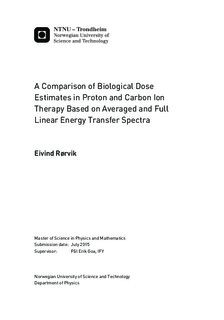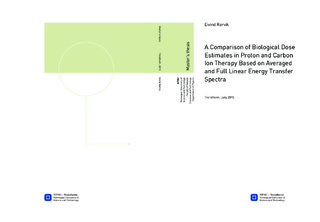| dc.description.abstract | Radiotherapy with ions, also known as particle therapy, is increasing rapidly. Shifting from photons to protons and carbons is not only a great technological transition, but also a shift in physics and in radiobiology.
To adapt from the higher biological effectiveness of particles compared to photons, the concept of relative biological effectiveness (RBE) is used.
Protons are slightly more effective than photons, and the RBE is set to be constant 1.1. The constant RBE value is not a physical property of the beam, it is simply assigned to be 1.1 by a consensus in the scientific community. Experiments indicate that the RBE in reality is marginally increasing along with the treatment depth. For carbon ions the variations in RBE are significantly higher and typically range between 1 and 3.
The variation is taken into account in treatment planning, however, relatively large uncertainties are present in the radiobiological models applied.
Many of these models are based on correlations between the calculated linear energy transfer (LET) and experimentally measured RBE. Most phenomenological models are based on the dose averaged LET. However, it should also be possible to correlate the biological effect to the full dose weighted LET spectrum, $d(L)$. By using a biological weighting function (BWF), it is possible to estimate the RBE from either dose average LET or dose weighted LET spectrum.
In this work, several proton and carbon ion beams were simulated with the FLUKA Monte Carlo code. The physical absorbed dose and the LET spectrum were estimated at different depths in a water phantom. A BWF was created upon existing cell experiments databases and applied to quantify the effect of the averaging. The biological effective dose (BED) was then estimated on either the average or the full LET spectrum.
The difference between the calculated BED of the two methods are under 2% for protons, as long as the BWF is close to linear in the relevant LET range. If the BWF is non-linear in the low LET region, the two estimates differ up to 17%, specially in the distal part of the spread out Bragg Peak (SOBP) and the in the distal dose falloff. However, for carbon ions, the dose estimates are significantly different. In particular, this is observed along the SOBP, where the BED estimated by the spectrum method is approximately 15% under the BED of the average method.
The results show that calculating the RBE by the averaging the dose weighted LET spectrum has little impact on the estimated BED from protons, as long as a linear approximation of the LET-RBE relation is chosen. The two estimates differs considerably for carbon ions, due to the peak in relevant LET region of the BWF. This difference should not be neglected, ergo it is not recommended to average the LET spectrum in radiobiological models used for carbon ion therapy. The implementation of the LET spectrum method could also be adapted to other radiobiological models based upon average LET. | |

